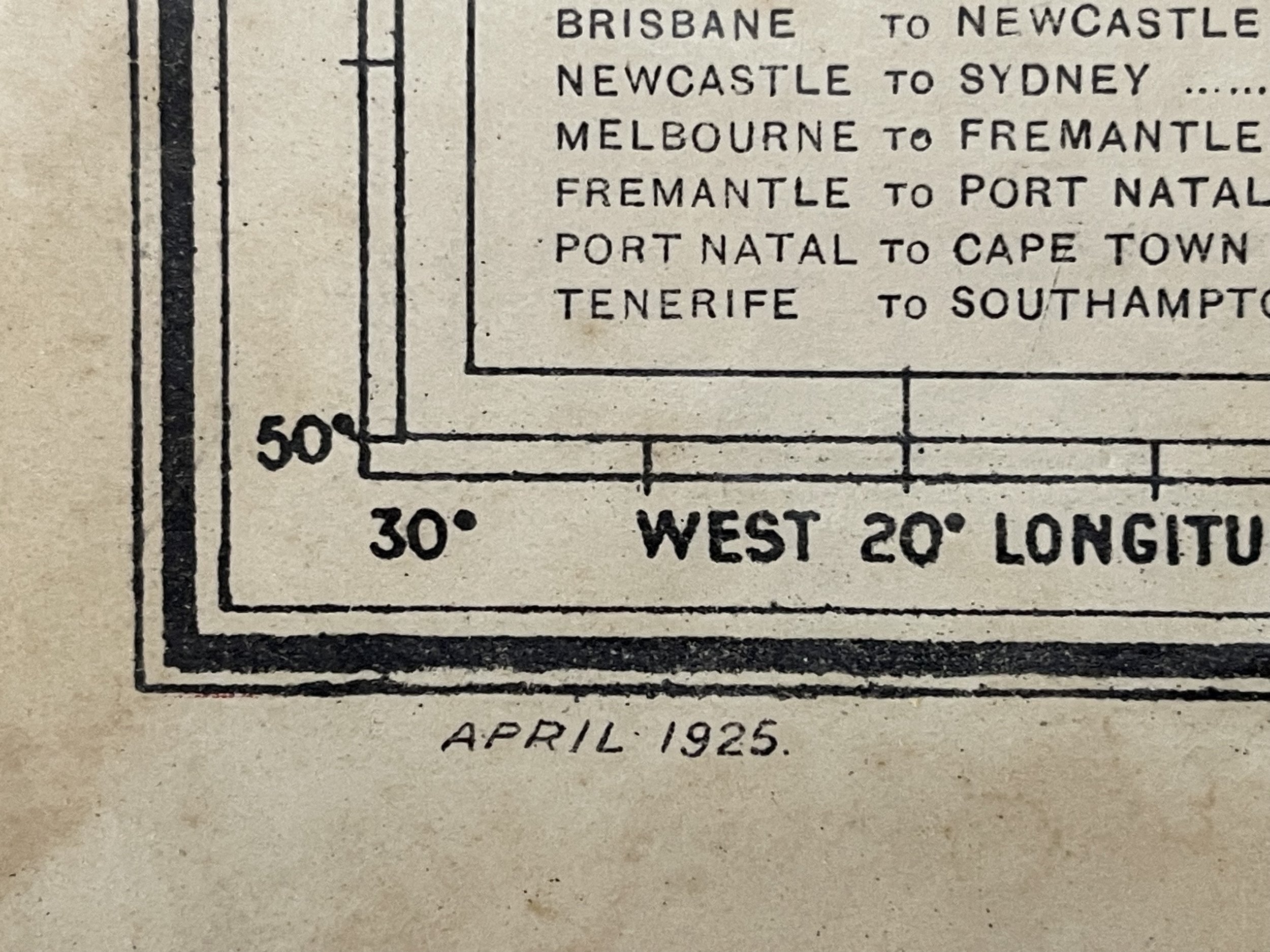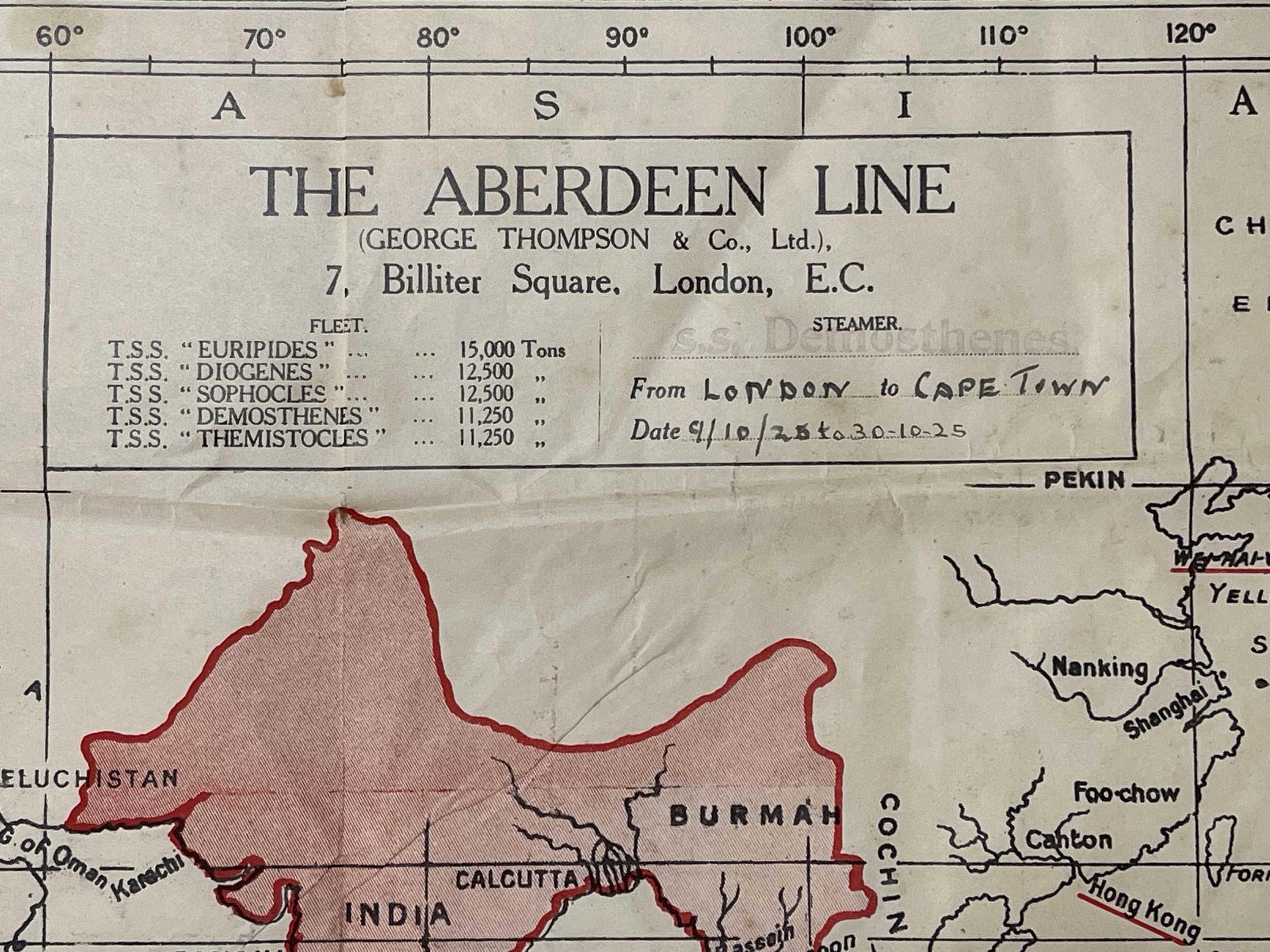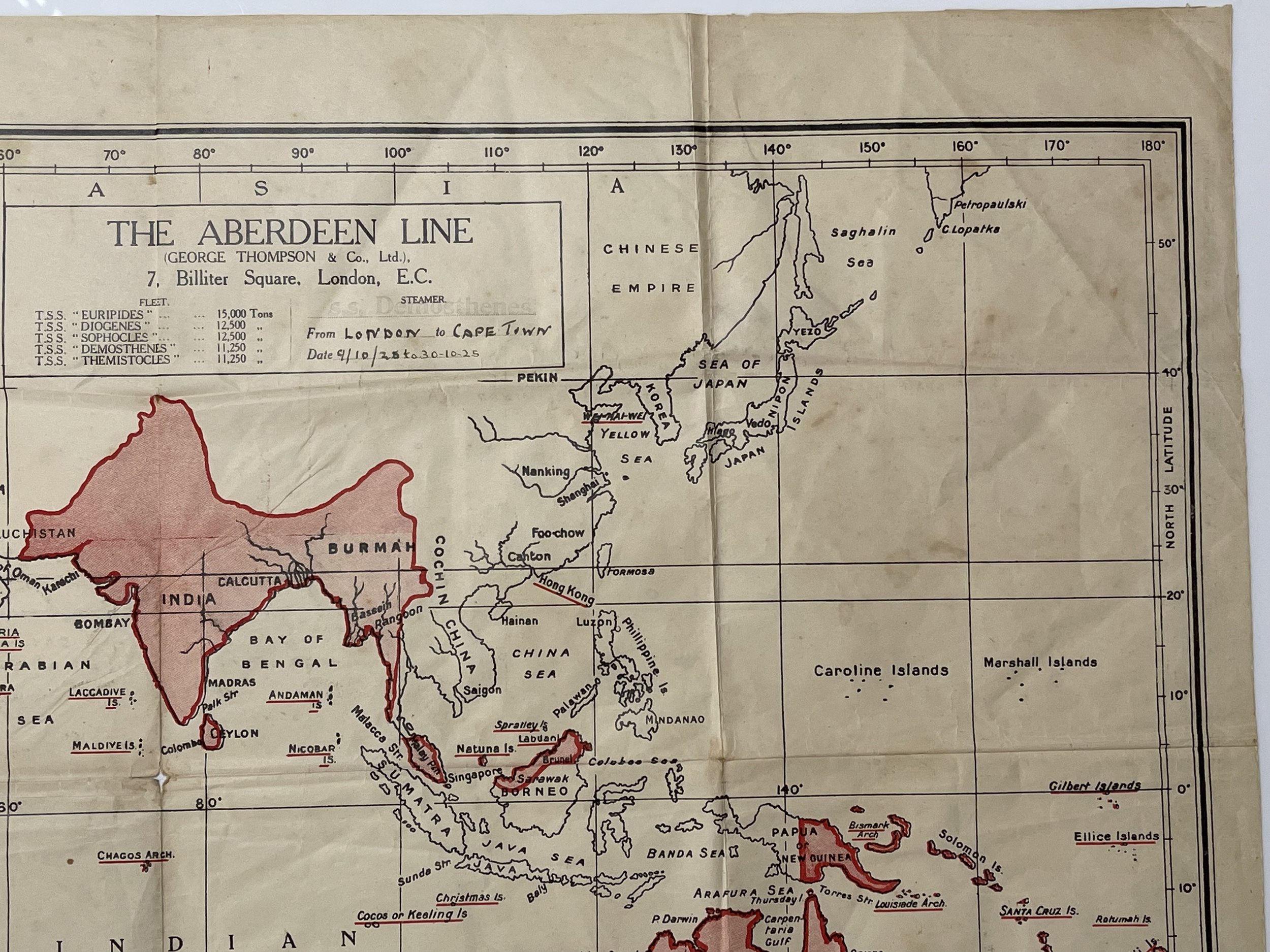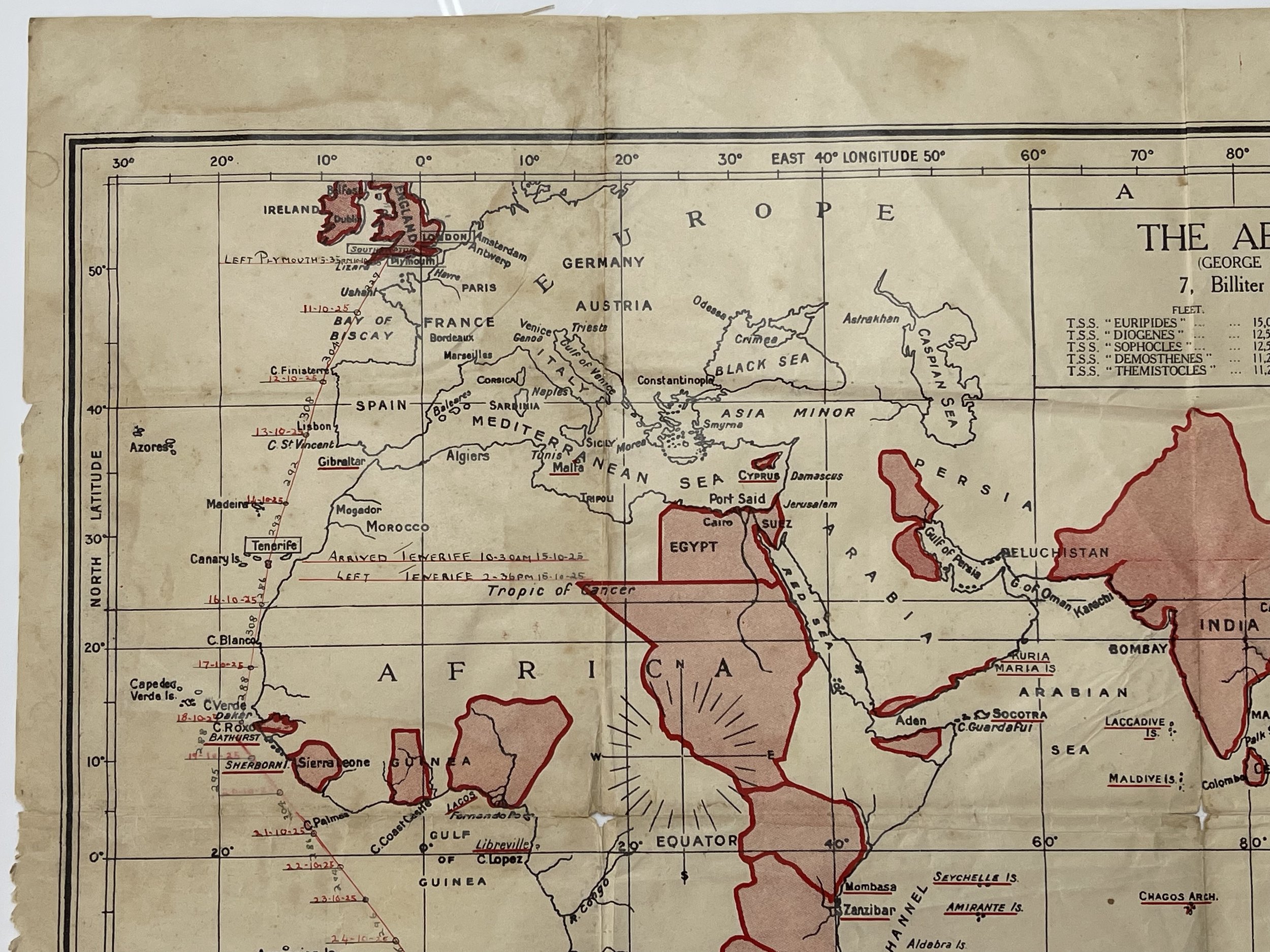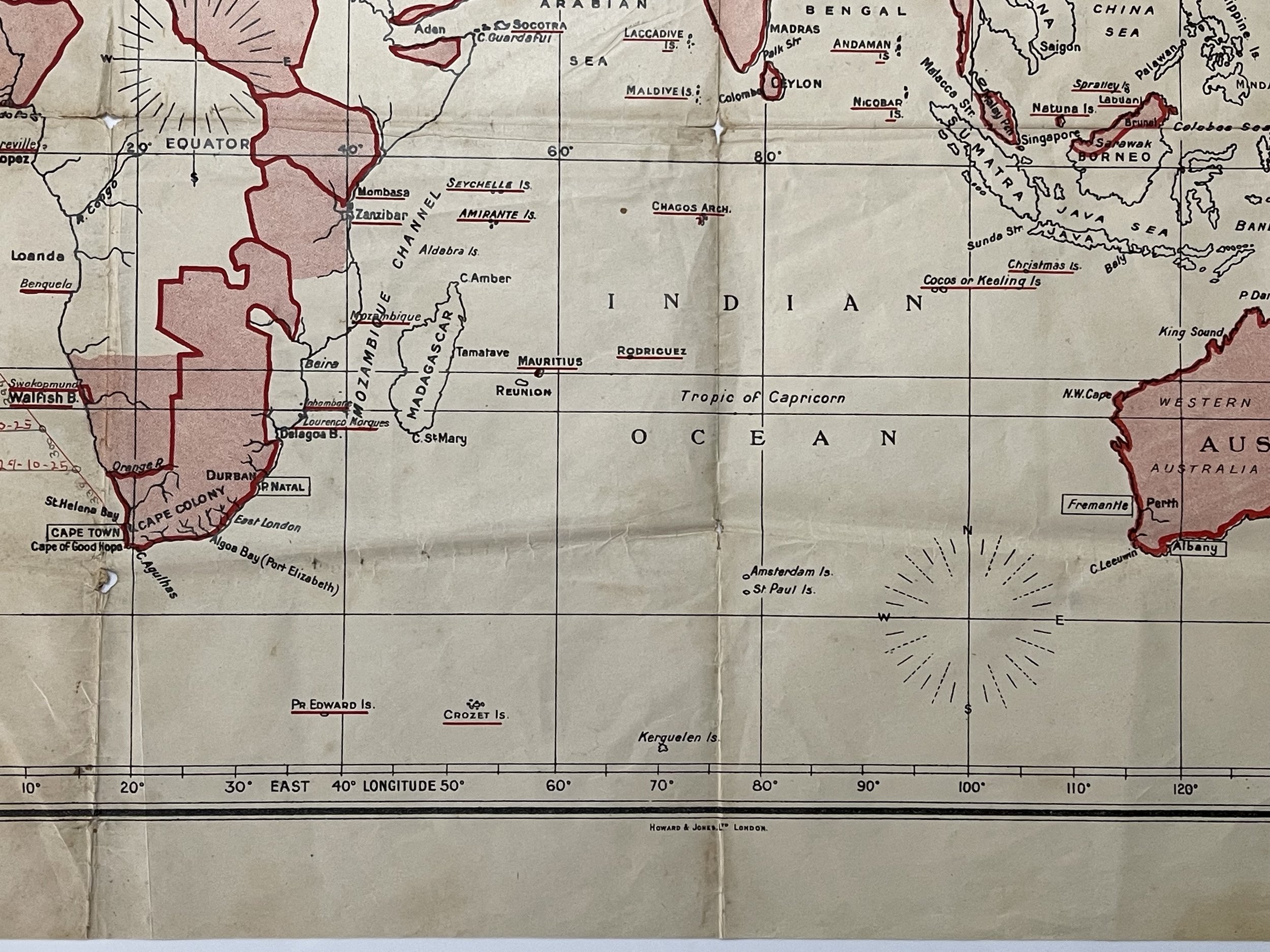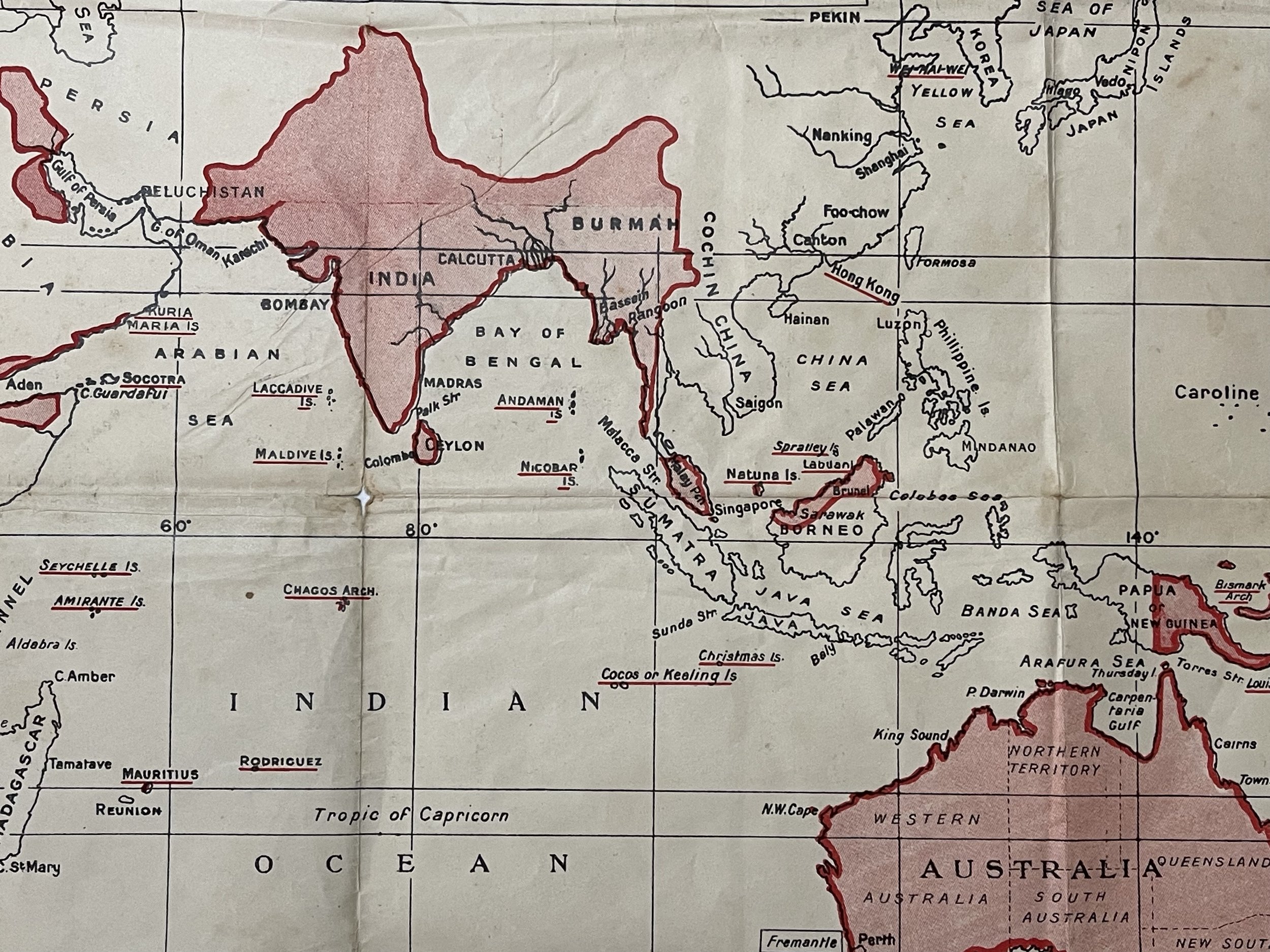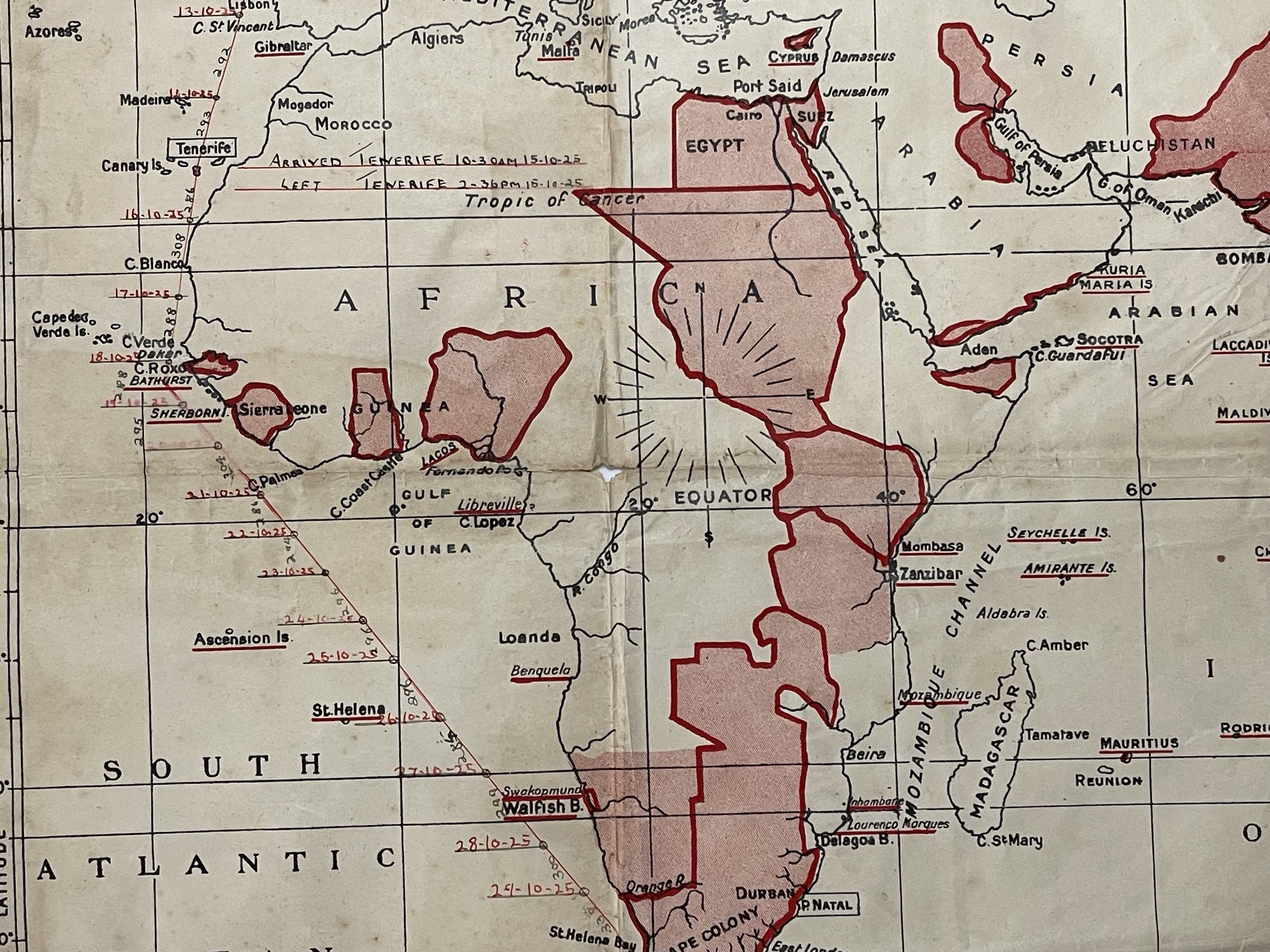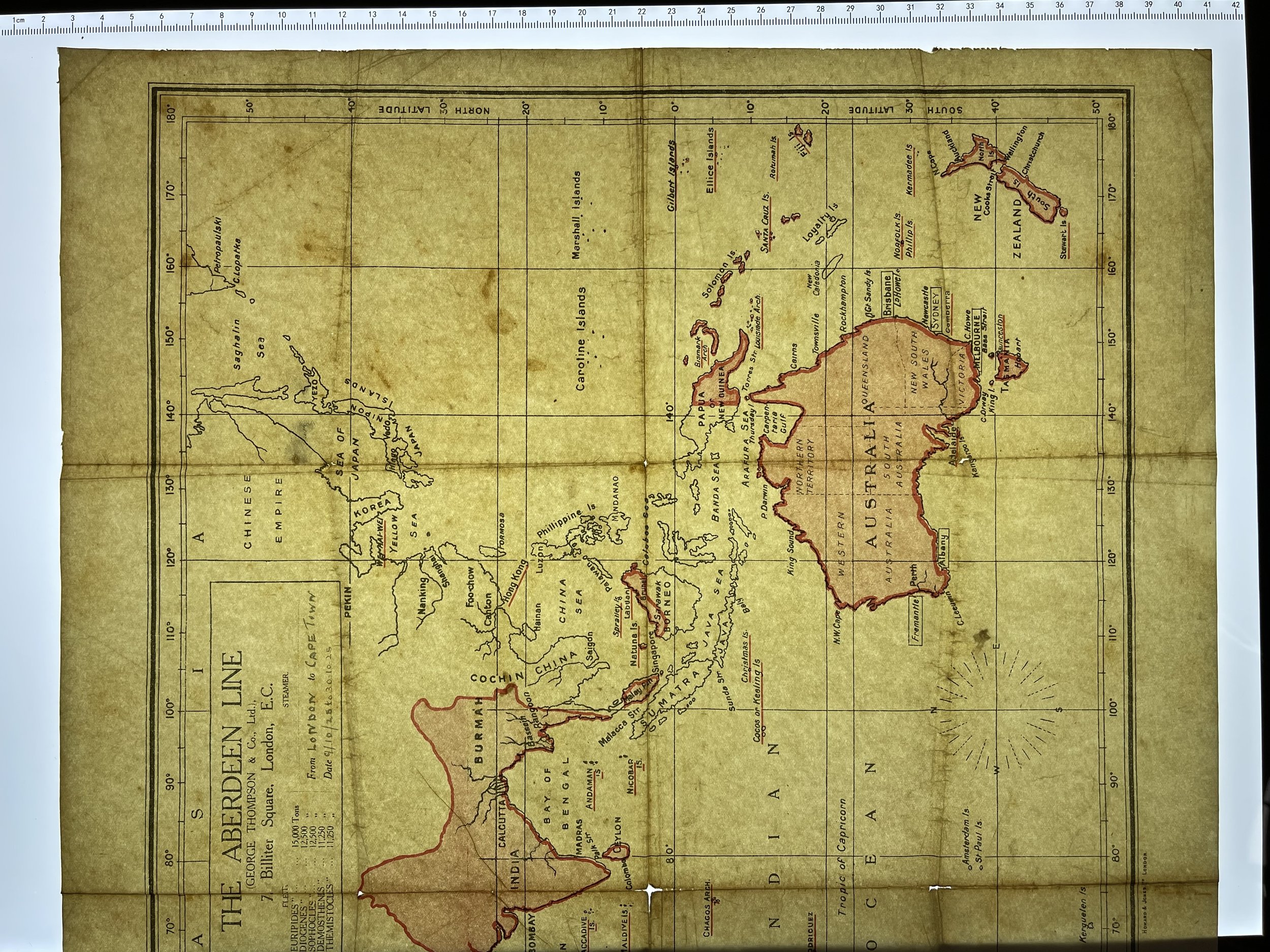Aberdeen Line World Passenger Chart / from the Steamer SS Demosthenes - 1925 - Scarce
London: SS Demosthenes (Aberdeen Line) travelling from London to Australia.
Demosthenes (1911) Aberdeen Line (British)
Built by Harland & Wolff, Ltd., Belfast, Ireland. Tonnage: 11,223. Dimensions: 500' x 62' (517' o.l.). Triple-screw, 15 knots. Triple expansion engines. Two masts and one funnel. Passengers: 100 first class. Fate: Scrapped in 1931. Sister ship: Themistocles. Service: England-Australia, via Capetown.
This map was printed by Howard & Jones Limited in April 1925 for the Aberdeen Line Steamship company passengers.
The Pink areas denote the British Empire or Dominion. This original map dates from 1925, so it includes places like Tanzania & Namibia, which were taken from Germany after WW1, and 'The Irish Free State' is still pink because it then had a kind of dominion status (like Australia) after its separation from the UK, not becoming a full republic until 1949.
This and similar maps were given to travellers on the Aberdeen Line ships during the period and rarely survive due to their delegate nature and tactile use during the long journeys.
Embarking at Brisbane, Sydney, Melbourne, Fremantle, Durban and Cape Town.
Aberdeen Line ship detailing its voyage from Portsmouth to Cape Town on 9.10.1925 to 30.10.1925. The daily progress of the voyage is annotated on the chart by the navigator, the time and distance sailed each day.
SS Demosthenes was a UK steam ocean liner and refrigerated cargo ship. She was launched in 1911 in Ireland for Aberdeen Line and scrapped in 1931 in England. In the First World War she was an Allied troop ship.
The Aberdeen Line was a shipping company founded in 1825 by George Thompson (Offices at 7 Billiter Square, London EC) of Aberdeen to take sailing vessels to the St. Lawrence River, carrying some passengers and returning with cargoes of timber. The business flourished and grew to 12 sailing vessels by 1837, travelling to South America, the Pacific, West Indies and the Mediterranean. In 1842 the line included a regular schedule from London to Australia.
The Aberdeen Line’s best-known ship was the clipper Thermopylae, launched in 1868, and constructed with the ‘Aberdeen Bow’, designed for greater speed and seaworthiness. The clipper set new records for voyages to and from Australia and the Far East. In 1872, her nearest rival, Cutty Sark, lost by seven days in a race from Shanghai to London. Thermopylae was acknowledged to be the fastest sailing ship afloat.
The arrival of the steamship signalled the end of the sailing era but enabled the line to introduce a regular service between London and Australia in 1882 and by 1899 all the vessels were able to carry frozen produce.
Changing fortunes put the company under joint control of White Star Line and Shaw, Savill & Albion Line in 1905, while retaining a degree of autonomy. In 1928 the White Star Line took over the Government-owned Australian Commonwealth Line, but in 1931 White Star Line's holding company, the Kylsant shipping group, collapsed. A year later Shaw, Savill & Albion bought the Aberdeen Line and in 1933 the former Australian Commonwealth Line was incorporated, and the Aberdeen & Commonwealth Line was founded. Furness Withy & Co took over Shaw Savill & Albion in 1936. By 1957 the last of the ships was scrapped and the company dissolved.
Aberdeen Line named some of its ships after classical Greek people and events. Demosthenes was a statesman and orator in Classical Athens in the fourth century BC.
London: SS Demosthenes (Aberdeen Line) travelling from London to Australia.
Demosthenes (1911) Aberdeen Line (British)
Built by Harland & Wolff, Ltd., Belfast, Ireland. Tonnage: 11,223. Dimensions: 500' x 62' (517' o.l.). Triple-screw, 15 knots. Triple expansion engines. Two masts and one funnel. Passengers: 100 first class. Fate: Scrapped in 1931. Sister ship: Themistocles. Service: England-Australia, via Capetown.
This map was printed by Howard & Jones Limited in April 1925 for the Aberdeen Line Steamship company passengers.
The Pink areas denote the British Empire or Dominion. This original map dates from 1925, so it includes places like Tanzania & Namibia, which were taken from Germany after WW1, and 'The Irish Free State' is still pink because it then had a kind of dominion status (like Australia) after its separation from the UK, not becoming a full republic until 1949.
This and similar maps were given to travellers on the Aberdeen Line ships during the period and rarely survive due to their delegate nature and tactile use during the long journeys.
Embarking at Brisbane, Sydney, Melbourne, Fremantle, Durban and Cape Town.
Aberdeen Line ship detailing its voyage from Portsmouth to Cape Town on 9.10.1925 to 30.10.1925. The daily progress of the voyage is annotated on the chart by the navigator, the time and distance sailed each day.
SS Demosthenes was a UK steam ocean liner and refrigerated cargo ship. She was launched in 1911 in Ireland for Aberdeen Line and scrapped in 1931 in England. In the First World War she was an Allied troop ship.
The Aberdeen Line was a shipping company founded in 1825 by George Thompson (Offices at 7 Billiter Square, London EC) of Aberdeen to take sailing vessels to the St. Lawrence River, carrying some passengers and returning with cargoes of timber. The business flourished and grew to 12 sailing vessels by 1837, travelling to South America, the Pacific, West Indies and the Mediterranean. In 1842 the line included a regular schedule from London to Australia.
The Aberdeen Line’s best-known ship was the clipper Thermopylae, launched in 1868, and constructed with the ‘Aberdeen Bow’, designed for greater speed and seaworthiness. The clipper set new records for voyages to and from Australia and the Far East. In 1872, her nearest rival, Cutty Sark, lost by seven days in a race from Shanghai to London. Thermopylae was acknowledged to be the fastest sailing ship afloat.
The arrival of the steamship signalled the end of the sailing era but enabled the line to introduce a regular service between London and Australia in 1882 and by 1899 all the vessels were able to carry frozen produce.
Changing fortunes put the company under joint control of White Star Line and Shaw, Savill & Albion Line in 1905, while retaining a degree of autonomy. In 1928 the White Star Line took over the Government-owned Australian Commonwealth Line, but in 1931 White Star Line's holding company, the Kylsant shipping group, collapsed. A year later Shaw, Savill & Albion bought the Aberdeen Line and in 1933 the former Australian Commonwealth Line was incorporated, and the Aberdeen & Commonwealth Line was founded. Furness Withy & Co took over Shaw Savill & Albion in 1936. By 1957 the last of the ships was scrapped and the company dissolved.
Aberdeen Line named some of its ships after classical Greek people and events. Demosthenes was a statesman and orator in Classical Athens in the fourth century BC.
London: SS Demosthenes (Aberdeen Line) travelling from London to Australia.
Demosthenes (1911) Aberdeen Line (British)
Built by Harland & Wolff, Ltd., Belfast, Ireland. Tonnage: 11,223. Dimensions: 500' x 62' (517' o.l.). Triple-screw, 15 knots. Triple expansion engines. Two masts and one funnel. Passengers: 100 first class. Fate: Scrapped in 1931. Sister ship: Themistocles. Service: England-Australia, via Capetown.
This map was printed by Howard & Jones Limited in April 1925 for the Aberdeen Line Steamship company passengers.
The Pink areas denote the British Empire or Dominion. This original map dates from 1925, so it includes places like Tanzania & Namibia, which were taken from Germany after WW1, and 'The Irish Free State' is still pink because it then had a kind of dominion status (like Australia) after its separation from the UK, not becoming a full republic until 1949.
This and similar maps were given to travellers on the Aberdeen Line ships during the period and rarely survive due to their delegate nature and tactile use during the long journeys.
Embarking at Brisbane, Sydney, Melbourne, Fremantle, Durban and Cape Town.
Aberdeen Line ship detailing its voyage from Portsmouth to Cape Town on 9.10.1925 to 30.10.1925. The daily progress of the voyage is annotated on the chart by the navigator, the time and distance sailed each day.
SS Demosthenes was a UK steam ocean liner and refrigerated cargo ship. She was launched in 1911 in Ireland for Aberdeen Line and scrapped in 1931 in England. In the First World War she was an Allied troop ship.
The Aberdeen Line was a shipping company founded in 1825 by George Thompson (Offices at 7 Billiter Square, London EC) of Aberdeen to take sailing vessels to the St. Lawrence River, carrying some passengers and returning with cargoes of timber. The business flourished and grew to 12 sailing vessels by 1837, travelling to South America, the Pacific, West Indies and the Mediterranean. In 1842 the line included a regular schedule from London to Australia.
The Aberdeen Line’s best-known ship was the clipper Thermopylae, launched in 1868, and constructed with the ‘Aberdeen Bow’, designed for greater speed and seaworthiness. The clipper set new records for voyages to and from Australia and the Far East. In 1872, her nearest rival, Cutty Sark, lost by seven days in a race from Shanghai to London. Thermopylae was acknowledged to be the fastest sailing ship afloat.
The arrival of the steamship signalled the end of the sailing era but enabled the line to introduce a regular service between London and Australia in 1882 and by 1899 all the vessels were able to carry frozen produce.
Changing fortunes put the company under joint control of White Star Line and Shaw, Savill & Albion Line in 1905, while retaining a degree of autonomy. In 1928 the White Star Line took over the Government-owned Australian Commonwealth Line, but in 1931 White Star Line's holding company, the Kylsant shipping group, collapsed. A year later Shaw, Savill & Albion bought the Aberdeen Line and in 1933 the former Australian Commonwealth Line was incorporated, and the Aberdeen & Commonwealth Line was founded. Furness Withy & Co took over Shaw Savill & Albion in 1936. By 1957 the last of the ships was scrapped and the company dissolved.
Aberdeen Line named some of its ships after classical Greek people and events. Demosthenes was a statesman and orator in Classical Athens in the fourth century BC.
Code : A637
Cartographer : Cartographer / Engraver / Publisher: Howard & Jones Limited
Date : Publication Place / Date - 1925
Size : Sheet size: approx 56 x 38.5 Cm
Availability : Available
Type - Genuine - 99years+ Antique
Grading A-
Where Applicable - Folds as issued. Light box photo shows the folio leaf centre margin hinge ‘glue’, this is not visible otherwise.
Tracked postage, in casement. Please contact me for postal quotation outside of the UK.


